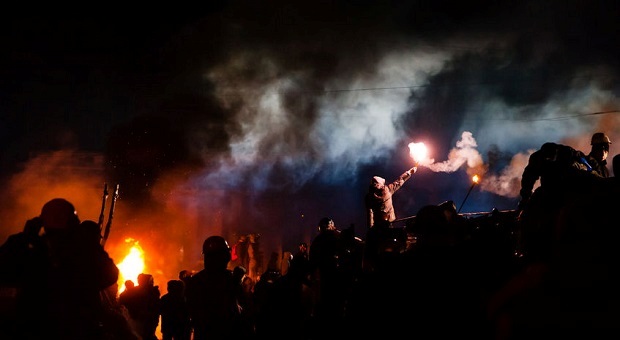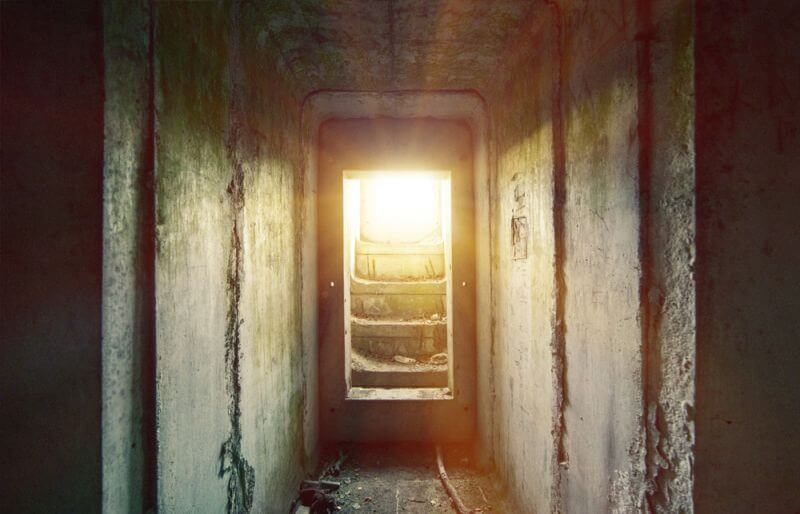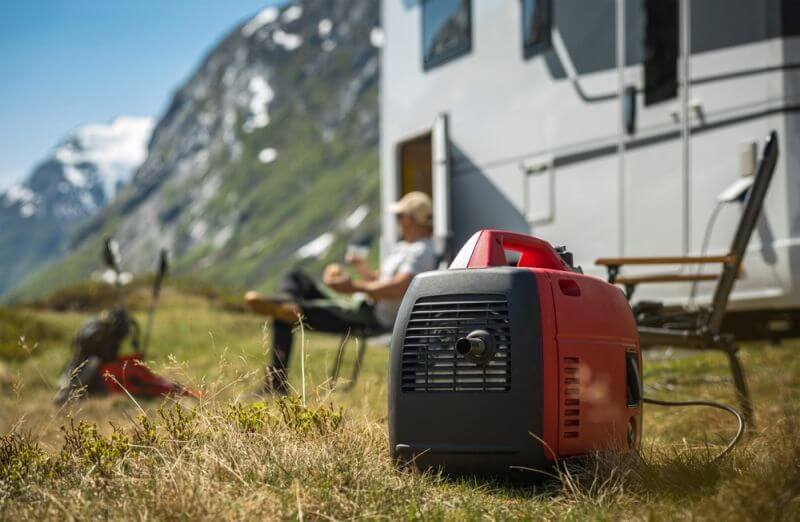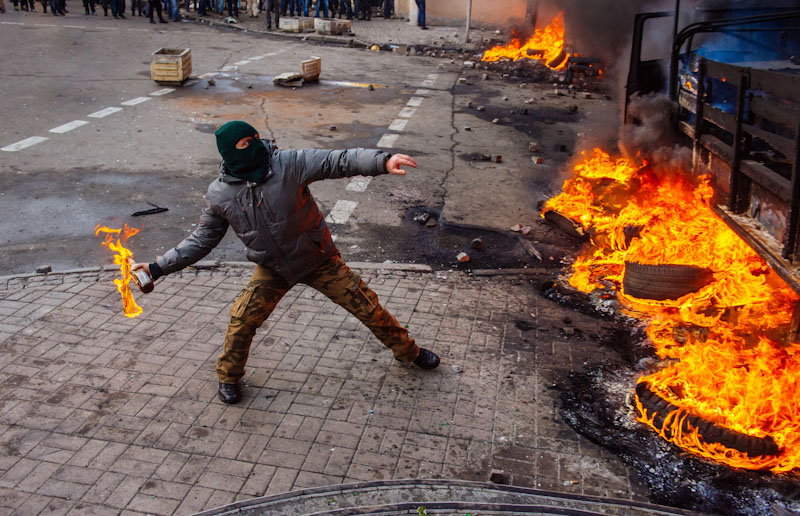You might be thinking, hey, I’ve got this one covered! I’ve survived lots of power outages. If that is your thought process, you could not be more wrong.
Anyone who considers, even for a moment, how interconnected and interdependent our existence has become … so full of overly-complex, over-engineered, over-automated systems driving every aspect of our increasingly fragile existence that is dependent on just-in-time inventory and shipping virtually everything we need ridiculous distances … arrives at the same inescapable conclusion: that mankind has built a house of cards.
I doubt we could have created a more fragile world if it had been our aim from the beginning. We have painted ourselves into a corner and we are going to make a mess getting out.
Few analogies are as simple and powerful as tripping an electrical breaker to disconnect a building from the grid. One moment the building is alive, bright, vibrant, buzzing. With the flip of a switch, it lays still, cold and dead.
On/off.
Alive/Dead.
It is truly that simple. One moment we have juice, the next we don’t.
The Chain Reaction
America’s need for power outstrips our investment in our capability to produce it by 400%.
Yet the legislative branch of government points fingers and the executive branch (well, what used to be the executive branch before we turned the zoo over to the chimps, so to speak) sits in its tower considering “jobs for jihadis” and throwing lavish parties to congratulate and reward itself for scamming the rest of us out of our tax dollars.
Meanwhile, our electrical infrastructure continues its rapid decay and the nation’s power grid slips and slides down a spiral water slide of demise. It appears that they could not possibly care less. Perhaps they figure somebody else will be in office to take the blame when the music stops.
But it is not just the US. The US economy affects the world economy and the world economy is feeling the pinch. You do not have to be a risk assessment genius to understand that a depressed world economy translates to more frequent power outages of increased duration and a weaker and more vulnerable power grid.
The grid is limping along on borrowed time. Through a combination of luck and the best efforts of the intelligence and military communities, we have dodged the CME/HEMP (Coronal Mass Ejection/High-altitude Electromagnetic Pulse) bullet … so far.
But while clock counts down to the next time the sun lobs an X-class solar flare in the general direction of our planet, the power industry has succeeded in using junk science generated by NERC (North American Electric Reliability Corporation) to pull the wool over the eyes of congress and emergency management bureaucrats alike, forestalling the Shield Act, which is our only hope to harden the grid against the inevitable threat of EMP, be it geomagnetic or manmade.
The 2012 India Blackout affected 620 million people or 9% of the world population. India’s engineers blamed in on a number of factors that were merely symptoms of the same illness that affects the US and most other power grids.
The chronic illness underlying the symptoms was that the industrial and technological revolutions have catalyzed humanity’s explosive growth for far too long.
This has woven fragility into very fabric of world’s power grids. This has become a growth bubble of epic proportions searching for a pin. Our sun and geopolitical climate has that bubble navigating terrain akin to the Sonoran Desert. In reality, it is not so much a desert, but a forest of cactus spines, fangs, thorns and stingers, all poised to plant themselves in passersby.
I am involved in emergency management and I am very blessed to have many good, competent government emergency managers all the way up to the state level. After that, it mostly government shills who fancy themselves emergency managers.
Especially at the Federal level, the US has fallen prey to a culture of academics who pretend to know inordinately more than they actually do. Rooted firmly in the personality ethic, “Fake it ‘til you make it.” is their motto, but they never do. Afraid of their own intellectual shadow, they fear embracing and admitting their own uncertainly, which is the first step to anyone truly learning anything. So they believe what is most convenient as opposed to what is true. In this case, it very convenient to have blind faith that the electrical grid, like everything else in their lives, is maintained by people and organizations more intelligent, wiser, more benevolent and more responsible than they are. “Move along, nothing to see here!”

Major vulnerabilities mean increased work load for emergency managers, and government shills resist having to actually provide a valuable service in trade for their salary.
Just this type of human debris, “working” for the City of Phoenix, Arizona concluded some years ago that an evacuation of Phoenix-Metro area is simply impossible.
So no such plan even exists. “Can’t win … don’t try.” They look to Homer Simpson for guidance on important issues like emergency plans that affect the lives of millions of people, including themselves and their own families.
I sincerely hope they have since remedied the situation, but I was not going to hold my breath and relocated to someplace with better prospects and better leadership.
The Countdown to Disaster
In order to understand how to prepare for a protracted power outage, you should understand the sequence of events that will unfold after the lights go out.
The electrical grid varies greatly from state to state and country to country, as do the threats to the grid, but here’s a sample of past events and future projections in form of a timeline.
It is a simple matter to put together a plan based on your family or organizational needs once you have an idea of what you’re preparing for so visualizing your mission and obstacles is sometimes more useful than the usual list of stuff you need have on hand and obligatory reminder to practice and train.
Immediately:
- Electric heating & cooling systems fail. In winter, homes will begin losing heat. In summer, many buildings dependent on air conditioning to maintain a safe temperature for occupants will be forced to evacuate.
- Many hospitals, radio stations, TV stations, telecomm systems and data centers switch over to emergency power but many lose air conditioning due to the expense of backup generators capable of supplying its heavy electrical load. Consequently, many data centers begin to heat up.
- Computers without uninterruptable power supplies or an integrated battery power lose power.
- Tall buildings reliant on most types of booster pumps lose water pressure past the bottom floors. Buildings with rooftop tanks have water until the tanks run dry.
- Entire cities lose water pressure forcing boil-water advisories into effect for any water that does make to you or that you manage to scrounge up. But without electricity, most households will be unable to boil water. The NE US Blackout of 2003 left millions of Michigan residents without any water.
- Many commuters are trapped on subways. Most electric subways and electric trains cease to function. Those that remain functioning reduce numbers of trains. In the Southern Brazil blackout of 1999, 60,000 commuters where on the subway system in Rio alone when it plunged into darkness. That blackout affected nearly 100 million people and triggered troop deployments. It was caused by neglect of the country’s grid due to a depressed economy. The event was triggered by an everyday lightning strike. Likewise, the NE US Blackout of 2003, affected all Northern states from Michigan up to NY and portions of Canada. Some 600 trains were stranded and thousands upon thousands had to be evacuated or rescued from subways and elevators.
- Most traffic lights go dark or default to 4-way stops. Traffic snarls due to failure of traffic controls. Increased numbers of traffic accidents and delayed emergency response times.
- Slowed traffic and calls to rescue thousands of people in elevators slows emergency response times.
- Most credit card terminals and point of sale terminals are inoperable, limiting commerce. Some transactions continue on a cash only basis.
- Most banks and ATMs (Automated Teller Machine) close or are inoperable, impeding most cash withdrawals.
- In large blackouts, cell service typically goes down before land lines, large due to increased call volume and lack of power to form many cell towers to transmit, but keep in mind that voice, and text messaging operate on completely different frequencies and systems. Text messaging often works when voice does not. Also keep in mind that the landline system operates independent of cell service is more robust.
- The 2012 India blackout shutdown multiple airports.
- Refilling prescription medication instantly gets a whole lot harder. Refilling controlled medications becomes next to impossible for most patients.
4 hours:
- Backup batteries on most alarm systems fail. If you own a brick and mortar small business, you either have to physically guard it or leave it vulnerable. If you own both a business and a home and commute between the two, you will have a hard time guarding them both. Many criminals are well aware of this fact and that law enforcement response times are slowing. Burglaries increase.
- Small portable generators need to be refueled. This will become a constant chore, very expensive and noisy security risk, so you are better off putting in a renewable energy source and battery bank while it is still possible or planning to only run your generator at certain times and doing all chores requiring electricity while it is running.
- Store shelves of business still in operation begin to empty.
- Price gouging, profiteering, panic buying and hording cause panic to mount, tempers to flare. Batteries, bottled water, flashlights, ice, candles and fuel are hardest hit and profiteers begin selling them in the streets.
- If cell phones or social media are still up, heavily-populated areas will see some flash mob-related crime.
- Any previously working phone circuits will likely be overloaded by now.
6 hours:
- Long lines form at gas stations still able to pump gas with battery-powered pumps or hand pumps as increasing numbers of motorists run out of fuel and many gas stations lose access to underground fuel tanks. They will only be able to accept cash.
- GMRS (General Mobile Radio Service) and FRS (Family Radio Service) radios rendered ineffective by “bubble pack” radio users and children. They will remain unusable from this point forward in most cities and suburbs. Smaller towns with redundant band plans will fare better, but will not be without major problems.
- Most folk will have had to “use the bathroom” by now. Many will discover that their toilets no longer flush. Are you prepared for this eventuality?
- By this point, if are well prepared, you will very likely have determined the scope of the outage, its probable duration and cause. You will most likely determine this via your emergency radio equipment such as AM/FM/SW emergency radios, scanners or amateur radio equipment. Depending on the scope and cause, you might have found out or figured out whether the blackout is due to grid failure, a geomagnetic event or an HEMP almost immediately. Understanding its probable scope and severity, however, may take some time and the use of your noggin, your ears and possibly asking the right people the right questions if you have ensured your ability to do ahead of time. Emergency responders and knowledgeable amateur radio enthusiasts, especially those who are part of ARES (Amateur Radio Emergency Service) will have a huge advantage over the average citizen when it comes to collecting and correctly interpreting intelligence about the emergency. If neither of these is your cup of tea, you might consider networking with someone so inclined ahead of time or you may find yourself doubly in the dark.
8 Hours:
- Utility companies set up generators to keep coms infrastructure up.
- People realize this is not just a minor blackouts where they will light some candles and play break out a board game for the kids.
- Small scale looting begins if hasn’t already. What happened, the ability of emergency services to inform the public, what they choose to tell people or the people having to figure it out themselves, may all have a significant impact on crime.
12 Hours:
- By the end of the first business day, blackouts cost gas stations and restaurants as much as $20K a day. Grocery store? Try more like 60K per day.
- Most refrigerators are now useless under normal usage patterns so most insulin-dependent diabetics lose the means to cool insulin.
Night fall:
- CPAP and oxygen concentrator users who have not invested in an alternative power solution will wake up fatigued at best and run the risk of not waking up at all.
- Crime rate goes up when the sun goes down.
Day 2:
- State of Emergency Declared. Troop deployments likely, if available. The Disaster Recovery Personal Protection Act of 2006, passed in 2007 specifically prohibits government officials from confiscating firearms in the aftermath of certain emergencies and natural disasters. Anyone who lies, cheats and steals their way into power these days seems to interpret the Constitution and Bill of Rights so broadly as to not apply to them or interprets one wiretap warrant to apply to hundreds of thousands of people. One such crook, former New Orleans police chief Eddie Compass, ordered police and National Guard units to confiscate firearms in the aftermath of Hurricane Katrina in 2005. To prevent this from happening again, The People passed a law specifying penalties should some future tyrant try it and manage to survive long enough to stand trial. This is very probable in Eastern US or the People’s Republic of Kalifornia, but I imagine anyone who tried that in most Western states would end up at the long end of a short rope shortly after the words exited his pie hole. So, will there be firearms confiscation? Probably not unless a state of martial law is declared, and then only in areas firmly under government control. But depending on how that administration uses that power, it might precipitate a premature “leadership vacuum. “
- Fuel rationing begins. Trucks start pumping out gas stations and truck the fuel to priority skeleton infrastructure.
- Freezers begin to thaw. Many people begin cooking thawing meat to preserve it or at least prepare it before it spoils. BBQ’s use far more propane to cook than camp stoves.
- Do yourself a favor plan involves a bug out and clean out your fridge before you leave. If you come back, you will wish you had. If you come back to warm fridge after an extended absence, don’t bother opening it. Just tape it shut, haul it to the dump and buy a new one. You’ll save yourself a lot of grief.
- Casualties and fatalities due to heat or cold exposure increase.
- Casualties and fatalities due to lack of access to healthcare and medication increase.
- Stores are likely cleaned out or soon will be.
- By this time, lacking passive solar design features, alternative energy sources, wood stove, kerosene heater or the like, your home will likely be getting pretty close to the same temperature indoors as out of doors minus the wind chill. In some climates, this is no big deal. In other climates this is a death sentence. Plan accordingly. You will need a whole lot more clothing than in a climate-controlled home. If it is cold, create a micro-climate in a single room or fewer rooms. It will be way easier to keep one room warm than a whole house. If you have vaulted ceilings throughout your entire home, set up a cabin tent in the living room and line it’s walls and roof with reflective blankets.
Day 3:
- 72 Hour Kits or typical bug out bags are used up or close to it. The average “prepared” citizen (as per FEMA’s over-optimistic recommendations based on past averages minus hurricanes, tornados and any other serious event because it is impossible that anything like that will ever happen again) runs out of emergency supplies and fuel to boil water.
- As fatigue, injuries and concern for their families takes a toll on first responders, law enforcement officers, firefighters, EMTs (Emergency Medical Technician), nurses and doctors begin to stop showing up for shifts.
- Rise in violent crime.
- Looting picks up momentum.
- Cases of waterborne and hygiene-related illness start to mount, further straining medical resources.
- Some better-organized cities set up mobile morgues in refrigerated reefer trucks. It might sound a little morbid, but it is a whole lot better than the alternative.
Day 4:
- Exhausted first responders and emergency personnel, nursing home staff and others have to prioritize dwindling resources where they can do the most good for patients with the best chances of recovery or survival.
- Once you start using your food stores, the type or types of food you chose will have a huge impact on the amount of fuel needed to prepare it. Soaking dry packed legumes and grains prior to boiling can help reduce fuel consumption, but it takes a lot more fuel to cook from scratch than it does to prepare a freeze dried meal or heat up an MRE (Meal Ready-to-Eat).
- By this time, cash may be have substantially less purchasing power and barter, mostly in the form of food, will eventually replace it.
Day 5:
- Hospitals are forced to consolidate. Smaller hospitals and urgent care facilities are forced to shut down and must be evacuated, causing healthcare workers or volunteers to face difficult choices and patients to suffer the consequences.
- Looting starts to die down because there isn’t anything left to loot.
Day 6:
- As reality sets in, doctors do the unthinkable and begin euthanizing patients they feel have low probability of survival. As demonstrated in the aftermath of Hurricane Katrina in 2005, this is considered acceptable practice and they will face no legal recourse if the blackout ends and society recovers. Due to limited quantities of medicine, no access to computerized medical records, lack of familiarity with the patients and lack of experience performing euthanasia, many of these attempts will fail, resulting in prolonged suffering, asphyxiation and hypoxic brain injury of patients who survive the attempt(s). This is sometimes due to the fact that patients with genetic tolerance to opioids and chronic pain patients undergoing opioid pain therapy will survive dosages far greater than a typically lethal dose.
- Some elderly patients in nursing homes were simply abandoned and left to die of dehydration and exposure during the aftermath of Hurricane Katrina. If you have loved ones in such a facility, you might want to keep this in mind.
Day 7:
- Cholera outbreaks and other serious fecal contamination-related and waterborne illness not seen in the US for decades or centuries begin to ravage cities, especially the large, coastal cities on the East Coast located far downstream from large populations. A protracted power outage will churn out epidemics, so it is prudent to plan for the eventuality.
- Unleaded and diesel-only generator owners who can still find fuel available are feeling the pinch as gasoline is many times more expensive and less available than natural gas in the majority of outages. Propane is cheaper than gas, but usually less available unless you have large capacity tanks.
- Some people that had been getting by looting businesses decide to give homes a try. Some see that the empty homes will soon run out and decide to transition straight to home invasion of occupied homes.
- If martial law has not been declared yet, they may give it a shot, but this would depend on the scope of the outage, prospects for recovery, political motives, geography, etc.
- If the power is still out and there isn’t a firm projection of restoration, you will likely be needing body bags soon if you have not already. Bodies can become a very serious microbiological threat and need to be properly handled and disposed of.
Are you prepared to face this?
This article has been written by Cache Valley Prepper for Survivopedia.










cATHERINE mCcOY | March 19, 2015
|
Best article I have seen on this
Mindy Morgan | March 20, 2015
|
This is one of the best articles I have read. It follows so much with one of the best books I have ever read on EMP’s and the power grid going down called “Nine Meals To Anarchy: Grid Down”. It’s by Farrell Kingsley and is the second book in the series. I highly recommend it to anyone who liked this article. Very educational for sure.
David Rollins | March 19, 2015
|
Good article. What about the following weeks and months?
Jerry | March 19, 2015
|
Note that in the case of an EMP attack, vehicles and most electronic devices may be rendered useless – additional big problem!!!!!!
Scott Todd | March 21, 2015
|
I keep a fair amount of tube gear active just for that reason.
leddy landers | March 19, 2015
|
This IS a great article. You did an excellent job. I’ve been trying to transition our home to old-fashioned “unpowered” tools and equipment. We’re getting older so some things are not so easy to switch over. I am always amazed by the number of people who cannot even fathom of any aspects of breakdown occurring. They blindly go on believing life will always be as it is now. That outlook is going to cost us all. Great job!
Pingback:Lights Off: How The World Could Change In 7 Days | March 19, 2015
|
Doug Nicholson | March 19, 2015
|
Something most people don’t think about in a grid-down scenario is nuclear power plants. If the employees at the plants can “scram” the pile, all should be well, but if not we could see melt downs resulting in radiation hazards.
Just_me | March 22, 2015
|
Nuclear power plants in the USA that are operating at power will automatically trip off line when the grid they are tied to goes down. (See GDC17 and NUREG/CR-90) The emergency diesel generators usually have 7 days worth of fuel in their fuel tanks, and up to another month of fuel in on-site fuel oil storage tanks. See 10CFR50.63 “Loss of all alternating current power.”
Neal Jensen | March 24, 2015
|
Im not sure I would trust any automatic equipment to shut down nuke plants, nor do I have high confidence that as things go from bad to worse, the employees shutting them down or making them safe from runaways, when they have families and their own safety to worry about. Doesn’t it take several days or weeks to really sutdown a nuke plant so it doesn’t go boom?
TPSnodgrass | March 19, 2015
|
CVP:
Well done, excellent article. I foresee much of what is coming when(not if) we get EMP’d by the NORKS. Yes, I am certain they will do it.
Most of our neighbors are oblivious to the concept of being prepared, even-though we live just south of you in Davis County. The mythology(no need to prep) that people in this state believe is mind-boggling to me. Keep up the writing, this was excellent.(and true in my experience)
jerry | March 20, 2015
|
What is NORKS?
TPSnodgrass | March 20, 2015
|
“What are NORKS?” Sorry, longtime blog reference to the North Koreans. Apologies.
Paul Gilbert | March 19, 2015
|
First thing I have is LED lights run on Batteries round the house which come on with movement they are small and last very Long 6 months on AAA the small ones there placed at or should I say above doors as exit maker also useful if there is a fire too so you know where to head
Also I have candles placed round the house with lighters taped to each one, it will be Sods Law that a blackout will happen at night if you’re not careful you can fall or even worse brake your foot or leg
and we don’t want that at the very start of when the SHTF
cATHERINE mCcOY | March 19, 2015
|
Some recommend keeping your car tank at least half full. I go to the station when it gets down a quarter. At least that will be one problem you dont have.
JayJay | March 20, 2015
|
My car is NEVER past 3/4 full. I always fill when going home.
I make it a habit.
Cost more only on the first fill-up.
Ron | March 22, 2015
|
We have small LEDs hanging on door nobs. One for each door.
Great Grey | March 30, 2015
|
Remember that LEDs are solid state devices and are likely to be damage in an EMP so having some old fashion flashlights around is not bad idea. Yes, LED lights are preferred but, you need some protected from EMPs and while go get them you may need an alternate light source find them.
Roxana Muise | March 19, 2015
|
Don’t forget to pray!
Paul Tuttle | March 19, 2015
|
Once a vial of injectable insulin is first used it has no need of refrigeration (in moderate weather) for 28 or 42 days. It is protected by preservatives. If it were me I would use the insulin until it turned cloudy (I asked a pharmacist). That and keep a careful watch on blood sugar.
Muriel | March 20, 2015
|
I have read that the native indians used to use blueberry leaf as a sort of insulin substitute for children with Type I diabetes. Might be worth researching?
Anubis | March 20, 2015
|
You can make an evaporative cooler out of 2 different sized pots, some sand, a towel and some water. They have been used since ancient Rome. You could get 2 cheap planters and duct tape the holes shut. They are called zeer pots now.
Pingback:Lights Off: How The World Could Change In 7 Days | Bug Out Network | March 19, 2015
|
deanbob | March 19, 2015
|
Great time line. It would be great to have an article on practical long term ideas such as would you recommend boarding up windows (why or why not); also, what is the latest on protecting (spare faraday cage protected car components) and getting out of Dodge.
Larry | March 19, 2015
|
Per Paul Tuttle’s thoughts on insulin, I only use pills, so it isn’t an issue for me, but I have wondered if my blood sugar METER would work after EMP. I presume it has electronics inside and as such might well be rendered useless. I also wonder about some of the other devices with electronic components like our sexy new styles of flashlights. You know – the ones with the little PC boards inside? And what about laser sights on firearms? Also, CPAPs were mentioned in the article – same thing – I’m pretty sure they are loaded with electronic components.
….I feel a Neanderthal moment coming on.
Clyde | March 20, 2015
|
Medical devices with any computerized component will not work. Your glucometer, if it is a newer one won’t work. Also, any fancy flashlights with an LED display won’t work.
Anubis | March 20, 2015
|
There is a big difference between an EMP that knocks out the power grid and one that knocks out hand held electronics. The difference is thousands of miles of power lines working like an antenna. If flashlights are getting taken out by the EMP you are too close to the nuke to be able to notice it.
Great Grey | March 30, 2015
|
You’re mixing up CMEs with EMP. CMEs will mostly affect only items that are plugged in. But, and EMP has an energy pulse that can damage any unprotected solid state device even if it is not anywhere near the grid.
JayJay | March 20, 2015
|
My husband made a great discovery. When taking a couple antihistimines, like allergy tablets, and the ceiling fan turning, he sleeps without the CPAP nicely.
It may not work for all–but we enjoy the break from the machine.
Scott Todd | March 21, 2015
|
Don’t know for sure but it’s possible your meter is small enough there won’t be enough charge to kill it. It’s when you have stuff with long wires attached that you get into trouble.
Pingback:Lights Off: How The World Could Change In 7 Days - MilitiaTV | March 19, 2015
|
Clyde | March 19, 2015
|
Read “One Second After” by William Forstchen. It tells the ongoing catastrophe after day #7 that will occur if it is an EMP.
Also read http://www.empcommission.org/docs/A2473-EMP_Commission-7MB.pdf
Some of us are truly prepared. Unfortunately, most are not.
Anne | April 3, 2015
|
I have not only read this book, but recommend it highly. If you want a glimpse of what life can be like after an EMP, read this book. Eye opening!
Pingback:Black Legion Militia | Lights Off: How The World Could Change In 7 Days | March 19, 2015
|
Unit Ed | March 20, 2015
|
Cache Valley Prepper did do an excellent job on portraying the possible grid down scenario! But it seems to me that much of the information, in this situation and other SHTF-type articles are aimed more at city dwellers and suburbanites rather than country dweller fellers! Out in the country, you could ride a horse or mule, grow your own food, raise animals and be more self-sufficient. Anyone that stays in the city, well, you have my condolences.
May Yahweh protect you and yours!
Dorothy Light | March 22, 2015
|
One thing us country people sometimes forget is that once the city and suburbs are almost looted-out, they will come for us, knowing that we are the most likely prepared, and might even still have food in the field. Rural people must be prepared to defend their homesteads by any means necessary. Hope it never actually comes to that.
Mic Roland | March 20, 2015
|
So WHY will GMRS and FRS be “rendered ineffective”? That wasn’t clear from that sentence. Sure, the usual EMP scenario is supposed to fry them, but that did not seem to be what you were saying.
DOF | March 24, 2015
|
I think he is referring to the channels being overloaded with chatter and traffic. Essentially GMRS and FRS operate on assigned frequencies or channels. It’s governed by people “sharing the air” . In a SHTF event, nobody’s sharing anything.
The Wiseman | March 20, 2015
|
An excellent article! Covers the Waterfront very well. I cannot emphasize enough, having the ability to defend your stash under any and all conditions. I continually hear from my bimbo and redneck neighbors (I live in the Pocono Mountains 2 hrs. from NYC) that “I ain’t agonna prepare for an emergency – I’m will just come and take yore stuff whenever I need it!” Think about this, brothers & sisters – when someone knocks on your front door, don’t simply open it to see who is there! Your door has a purpose – to keep the world outside!
JayJay | March 20, 2015
|
Begin a habit of storing all meats in large ziplok bags–if freezer fails, you’ll thank yourself later!!!
Been there. And we had a quarter side beef and lots of chicken/bacon since I am a prepper.
Muriel | March 20, 2015
|
“The Knowledge: How To Rebuild Our World From Scratch” by Lewis Dartnell is an excellent book on how to (hopefully) bootstrap civilization in the event of an apocalypse. The author starts with the most basic- growing crops, making soap etc, and moves on to making charcoal, mining coal, steam engines and onward. I found it hopeful- maybe if enough people have this knowledge, we won’t plunge as far into the abyss. One thing I remember noticing: during Katrina, one of the few building ignored by the looters was the public library.
Tara | August 24, 2015
|
The library has always been on my looting go-to list! Haha! I’m not a looter. I can never imagine being one. But…if I had to…There is so much knowledge just sitting there in one place. And if you were VERY desperate, (I hate to say it) books could be burned as fuel/heat 🙁
messenger | March 20, 2015
|
Absolute best kick me in the nuts article I’ve ever read. I don’t know what you get paid, but it is not enough. The Lord be with you all the days of your life.
Scott Todd | March 21, 2015
|
CVP- great article for the most part. I’d take slight issue with your charges of profiteering and price gouging however. One of the reasons prices shoot up in a crisis is that costs get based on what the store owner thinks it’ll take to replace the sold items, which could indeed go very high. One actual benefit is that instead of the first few people scarfing up all the flashlights, for instance, by raising the prices folks might buy just one or two, leaving more for those who come after. I’d highly recommend Thomas Sowell’s book Basic Economics.
Richard Muszynski | March 22, 2015
|
Question this comment. it suggests that the existing supplies that cannot be replaced would be simply treated as a everyday concern and replacements will arrive shortly. When it hits the fan profit is no longer of any interest. money would not be either. Money is only a means of exchange more convenient then barter. If there are no replacements for things sold, then money as a trade convenience would be totally useless. economics requires there to be an economy to function. no economy. no economics theory viable.
Scott Todd | March 23, 2015
|
In an SHTF scenario you’d be entirely correct. However, it may not be immediately obvious that this might be a years-long recovery and they’ll be treating it as a weeks-long disaster like Hurricane Sandy. They’ll treat it as the latter and act accordingly.
Pingback:Lights Off: How The World Could Change In 7 Days - Apocalypse Supplies | April 20, 2015
|